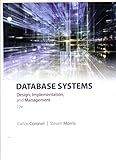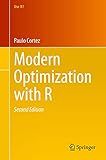Best Database Optimization Tools to Buy in December 2025

Database Systems: Design, Implementation, & Management



Database Systems: Design, Implementation, & Management



Modern Optimization with R (Use R!)



High Performance MySQL: Optimization, Backups, Replication, Load Balancing & More (Advanced Tools and Techniques for MySQL Administrators)



Practical Python AI Projects: Mathematical Models of Optimization Problems with Google OR-Tools



Database Systems: Design, Implementation, & Management


Creating an index in MySQL can significantly improve the performance of queries on large tables. An index is a data structure that improves the speed of data retrieval operations on a database table by providing quick access to the rows that match certain search conditions.
To create an index in MySQL for better performance, you can follow these steps:
- Identify the columns: Determine the columns on which you want to create an index. Choose columns that are frequently used in search conditions or commonly used for joining tables.
- Choose the index type: MySQL provides various index types, such as B-tree, hash, R-tree, and full-text. B-tree indexes are most commonly used as they efficiently handle many types of queries.
- Create an index: Use the CREATE INDEX statement to add an index to one or more columns. For example, to create a single-column index on a column called 'name' in a table called 'users', you would use the following syntax: CREATE INDEX idx_name ON users (name);
- Consider composite indexes: If you frequently use multiple columns together in search conditions or join operations, you can create composite indexes. These indexes span multiple columns and can improve the performance for queries involving those columns.
- Analyze the impact: After creating an index, analyze the query execution plans and timings to determine if it is improving the performance. You can use the EXPLAIN statement to understand how the query is being executed and determine if the index is being utilized.
- Regularly update statistics: MySQL keeps statistics about the data distribution in tables, and these statistics help the query optimizer choose a suitable execution plan. Regularly update the statistics using the ANALYZE TABLE statement to ensure accurate query optimization.
- Drop unnecessary indexes: Over-indexing can negatively impact the performance of write operations and increase the storage requirements. Periodically review and drop any redundant or unused indexes to optimize the overall performance of your database.
Remember, creating indexes is a balancing act. While they can significantly improve the performance of queries, they also come with overhead for inserts, updates, and deletes. It's essential to carefully select columns and index types based on the specific requirements of your application.
How to create a primary key index in MySQL?
In MySQL, you can create a primary key index while creating a table or by altering an existing table. Here are the steps to create a primary key index:
Method 1: Creating a primary key index while creating a table
- Start by creating a new table using the CREATE TABLE statement. Specify the table name and its columns, along with their respective data types.
- Identify the column that will serve as the primary key. Typically, this column stores unique values for each record.
- Attach the PRIMARY KEY constraint to the specified column. You can do this by adding the PRIMARY KEY keyword followed by the column name within parentheses after defining the column's data type.
- Execute the CREATE TABLE statement to create the table along with the primary key constraint.
Here's an example of creating a table with a primary key index:
CREATE TABLE users ( id INT PRIMARY KEY, name VARCHAR(50) );
Method 2: Creating a primary key index by altering an existing table
If you want to add a primary key index to an existing table, follow these steps:
- Write an ALTER TABLE statement to modify the table structure.
- Specify the table name after the ALTER TABLE part of the statement.
- Add the ADD keyword, followed by the PRIMARY KEY keyword, and then the column name within parentheses. This column will become the primary key.
- Execute the ALTER TABLE statement to add the primary key constraint to the table.
Here's an example of adding a primary key index to an existing table:
ALTER TABLE users ADD PRIMARY KEY (id);
Note that you can only have one primary key per table, and the primary key must contain unique and not-null values.
How to use partial indexes in MySQL for better performance?
Partial indexes in MySQL can be used to optimize query performance by creating indexes on a subset of the table's data instead of the entire table. This can be particularly useful when a table has a large amount of data but only a portion of it is frequently accessed or queried.
Here are the steps to use partial indexes in MySQL for better performance:
- Analyze your data: Identify which columns or conditions are frequently used in queries that can benefit from partial indexing. For example, if you have a large table with a column indicating the status of a record and most queries only include active records, you can create a partial index on the active records only.
- Create a partial index: Use the CREATE INDEX statement to create a partial index on the specific column(s) or condition(s) of interest. For example, to create a partial index on the 'status' column for only active records, you can use the following syntax: CREATE INDEX idx_active_records ON your_table (status) WHERE status = 'active'; This will create an index that only includes rows where the status is 'active'.
- Test and analyze performance: Execute your queries and measure the performance improvement. Compare the query execution time before and after creating the partial index. You can use the EXPLAIN statement to examine the query execution plan and see if the partial index is utilized. EXPLAIN SELECT * FROM your_table WHERE status = 'active'; Look for the "possible_keys" column in the output of the EXPLAIN statement. If the partial index is registered as a possible key, it means the optimizer recognizes it as a potential option to improve query execution. Note: Partial indexes can only be used when the query condition matches the partial index condition. If your query doesn't use the same condition, the index will not be utilized.
- Monitor and maintain: Regularly monitor the performance of your queries and analyze whether the partial indexes are still effective. If your data distribution changes or query patterns shift, you might need to adjust or create new partial indexes accordingly.
Remember that partial indexes, like any indexing strategy, can have trade-offs. They can improve query performance but may also increase storage size and decrease insert/update performance. Therefore, it's important to carefully analyze and test the impact of partial indexes on your specific use case before implementing them.
What is the impact of indexes on SELECT queries in MySQL?
Indexes have a significant impact on SELECT queries in MySQL. Here are some of the key impacts:
- Improved query performance: Indexes help improve the performance of SELECT queries by allowing the database engine to locate the required data more quickly. Instead of scanning the entire table, indexes allow for more efficient retrieval of specific rows based on the indexed columns.
- Faster data retrieval: With indexes, SELECT queries can retrieve data from the database much faster as the database engine can directly access the relevant index entries and retrieve the corresponding rows, rather than scanning the entire table.
- Reduced I/O operations: Indexes reduce the number of disk I/O operations needed to locate the requested data. By having an index, the database engine can quickly navigate through the index structure to pinpoint the desired rows.
- Optimization of WHERE clauses: Indexes help optimize the evaluation of WHERE clauses in SELECT queries. By using indexes on columns mentioned in WHERE clauses, the database engine can efficiently filter out unrelated rows, resulting in faster queries.
- Order by and Group by optimizations: Indexes can significantly improve sorting and grouping operations in SELECT queries. By using indexes on the columns mentioned in the ORDER BY or GROUP BY clauses, the database engine can retrieve and process the related rows more efficiently.
- Impact on write operations: While indexes greatly enhance SELECT query performance, they can have a slight impact on write operations such as INSERT, UPDATE, and DELETE queries. When modifying data in a table, the corresponding indexes need to be maintained and updated, which can marginally affect the overall performance of such operations.
Overall, indexes play a crucial role in optimizing SELECT query performance in MySQL by facilitating faster data retrieval, reducing I/O operations, and helping with query optimization. However, it is essential to design and use indexes carefully to strike a balance between query performance improvements and the overhead they may introduce on write operations.
